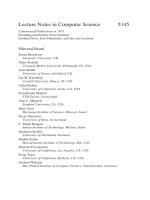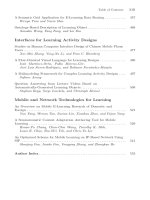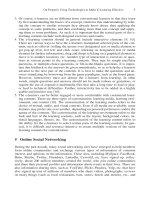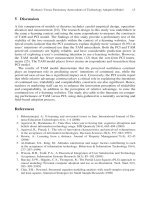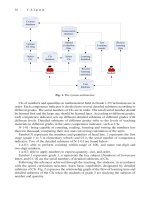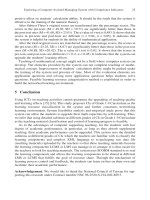Lecture Notes in Computer Science- P37 pptx
Bạn đang xem bản rút gọn của tài liệu. Xem và tải ngay bản đầy đủ của tài liệu tại đây (1.03 MB, 5 trang )
Motivating Students through On-Line Competition 169
In another line, Kim and Sonnenwald [12] use the scale of learning preferences of
Owens and Barnes to identify three learning styles: cooperative, competitive and
individualized. The cooperative learning style indicates a preference for achieving
individual goals while working in group; students work together to maximize their
own and each other’s learning. The competitive learning style indicates a preference
for learning in competition with others, often achieving individual goals; students
work against each other to achieve a good grade and only some of them succeed.
Lastly, the individualized learning style indicates a preference for “working by one-
self to ensure that one’s own learning meets a present criterion independently from
the efforts of the other students” [13]. Moreover, Grasha and Riechmann have devel-
oped the Student Learning Styles Scale to measure the preferences of students in
interacting with teachers and other students where they determine six categories:
participative, avoidant, collaborative, competitive, independent and dependent [14].
It would seem logical to think that, for example, competitive and independent stu-
dents feel more motivated through competition than through collaborative learning.
The idea of competition is usually linked to gaming, and games are often pleasing for
any kind of student, In fact, the intention of incorporating gaming elements into learn-
ing has received increasing attention recently [15] [16]. So, for example, Siddiqui,
Khan and Katar [17] present a case of application of simulation games. They tested a
supply chain simulator and observed a higher sense of competition amongst students.
In addition, their results clearly showed a significant increase in students’ motivation.
Games have a number of characteristics that make them attractive from a
pedagogic and instructional point of view. Therefore, there are some systems that
implement games as an effective method to capture student interest, encourage active
learning and increase motivation [18] as well as fun and learning [19]. Fasli and
Michalakopoulos [20] stay that “the nature of the game itself and the competitive
element involved, act as an incentive for all students to put in more effort and even
weaker students persist with playing the game”.
Moreover, there are also studies that analyse possible negative factors of competi-
tion and compare different competition approaches: anonymous, of known authorship,
face-to-face, etc. Yu, Chang, Liu and Chan [21] examine students’ preferences to-
wards different kinds of competition and their satisfaction with regard to the learning
experience. Their results show that students prefer anonymous rather than face-to-face
competition, since the former is more likely to reduce stress and other similar nega-
tive emotions. In fact, results from studies conducted in traditional classroom have
showed negative effects of competition on interpersonal relationships and emotional
states. However, those studies involved face-to-face situations, where, without the use
of networking technologies, the identity of the participants could not be hidden.
ICT could mitigate the negative effects of face-to-face competition by hiding the
identity of students if necessary. An example of the success of this possibility is the
QUESTournament system, where networking provides the support of anonymity that
allows teachers to design learning strategies adapted to the anonymous competition
mode. Moreover, QUESTournament allows team competitions which combine the
better of competitive learning with the better of the collaborative learning (as ex-
plained below).
Finally, it is important to show that there is not an overabundance of research in the
area of learning styles and e-learning. Most of the studies focus on the discovery of
170 L.M. Regueras et al.
relationships between learning styles and specific student achievement outcomes
(drop rate, completion rate, attitudes about learning…) [14] [22] and between learning
styles and the learning environment [23].
Knowledge of student learning preferences could provide a bridge to course suc-
cess. It is important that an individual’s learning style is examined for compatibility
with the educational learning environment.
3 The QUESTournament System
The QUESTournament system - previously called QUEST (Quest Environment for
Self-managed Training) system - is an innovative tool for active ICT-based learning,
whose aim is the development of cooperative and competitive workshops supported
by telematics. This system pursues the development of student inquiry, documenta-
tion and critical analysis skills, while raising the level of involvement and communi-
cation between students and teachers.
QUESTournament is accessible from every computer with Internet access and a
Web browser and has been implemented as a module integrated into the e-learning
platform Moodle in order to offer a new type of activity for the courses delivered
through that platform.
The QUESTournament system presents both individual and group work environ-
ments in which teachers and students propose “challenges” that must be solved in a
time-constrained way.
The answers to the proposed challenges can be of any type of those most usual
within the current assessment tests. Therefore, each and every type of question (essay,
tests, short answer…) can be included. Besides, files in different formats can be at-
tached to the answers. Once submitted, these ones are rewarded by means of a vari-
able scoring system.
QUESTournament has been designed to motivate students through competitiveness
and collaboration. Hence, work sessions are presented as a contest that involves sev-
eral tasks or challenges. The contest ranking is based on the scores for each challenge
and it is dynamically updated every time that a student’s answer is scored.
Students are allowed and encouraged to submit their own challenges related to the
course and to evaluate the corresponding answers. Their work will be rewarded de-
pending on the quality of the proposed challenge as well as the accuracy of the as-
sessments and the feedback offered to other contestants. In this way students get more
involved and collaborate to enrich the learning process.
As seen in Fig. 1, the QUESTournament system displays a permanently updated
top ranking with a link to a detailed scoreboard. There are both individual and team
rankings. Besides, all the challenges proposed by teachers or students are shown in
the main area of the screen. The challenges proposed by students must be previously
approved and scored by a teacher, although it is also possible to set up the system to
allow automatic approvals. In fact, one key design point of QUESTournament is
flexibility. There are many ways in which teachers can use the system; they can
change the maximum and minimum values for the scoring function, the number of
answers to be accepted, etc.
Motivating Students through On-Line Competition 171
Fig. 1. Main screen of the QUESTournament system
Each challenge has a set of assessment criteria to be used by the author for evaluat-
ing the answers that is known by every participant beforehand. There is also a general
set of criteria to evaluate the challenges proposed by the students.
To sum up, QUESTournament encourages students to actively participate and gen-
erate contents in a dynamic and changing environment. Students’ submissions are
anonymous but accessible to everyone, providing competitive but also reciprocal
learning. A more completed description of QUESTournament can be found in [24].
4 Research Methodology
Several studies [25] [26] suggest that students’ satisfaction and motivation are important
factors in measuring the success or effectiveness of the e-learning process. Consequently,
172 L.M. Regueras et al.
this study proposes to measure students’ satisfaction with QUESTournament in order to
find out the effect of competitive e-learning on higher education students and to analyse
it according to the different students’ learning styles.
4.1 Hypotheses
It has been proposed that there are many factors that promote or hinder the success of
students. Among these factors, motivation and satisfaction have been linked to student
attrition and performance [27] [28]. Moreover, student satisfaction is associated with
student achievement [29] and it is also a key indicator of educational quality [30]. So,
this study proposes the following set of hypotheses related to the students’ satisfaction
and motivation according to their learning styles:
H1. The level of satisfaction of competitive students will be higher than that of non-
competitive students when using a competitive active learning tool.
H2. The level of satisfaction of participative students will be higher than that of non-
participative students when using a competitive active learning tool.
H3. The level of satisfaction of non-collaborative students will be higher than that of
collaborative students when using a competitive active learning tool.
4.2 Methodology and Instruments
One instrument has been used in this study with two parts. The first one is a ten-item
survey based on the method developed by [25], which measures students’ satisfaction
and motivation in e-learning environments. It provides students with a five-score
Likert-type scale, which ranges from ‘‘Strongly Disagree’’ to ‘‘Strongly Agree’’.
Students’ satisfaction total score, generated by summing up all the scores, can range
from a minimum of 10 (very low satisfaction level) to a maximum of 50 (very high
satisfaction level). According to previous literature [31] [32], items relating to student
interaction, collaboration and active learning have been included in the students’
satisfaction survey.
The second part is a questionnaire with several questions about the students’ learn-
ing style based on three of the categories of the Grasha-Reichmann Learning Style
Scales (GRSLSS): participative, competitive and collaborative.
4.3 Data Collection
Data were collected on line, using the instruments described above, during June 2006.
The survey was set to collect responses using the “phpEsp” survey system. Data sub-
mission was anonymous with no link between a submission and its author.
QUESTournament is currently being applied in different university courses in both
Arts and Science degrees. Specifically, during the academic year 2005 – 2006, the sys-
tem was used in 10 courses in different degrees and diplomas taught at the University of
Valladolid: Degree in Telecommunications Engineering, Diploma in Telecommunica-
tions Engineering (several specialities) and Degree in Translation and Interpreting with
a total of 522 enrolled students. Enrolment on most of these courses was below 50 stu-
dents and most of them were taught by only one teacher. However, there were some
courses with over 100 students enrolled and courses which were taught by more than
Motivating Students through On-Line Competition 173
one teacher (specifically, by two teachers). Therefore, the test environment counted with
a sufficiently varied course spectrum.
5 Analysis and Results
The collected data have been analysed for group comparison using Student T-Test for
students’ satisfaction. This statistic assesses whether the means of two groups are
statistically different from each other in order to be able to compare them.
5.1 Analysis of Students’ Satisfaction and Motivation
In order to know if the system was successful, it is important to analyse the level of
students’ satisfaction from the survey data. About 30% students completed the survey
(129 of the 447 students who used QUESTournament). The collected sample was
provided online via the Web-based survey system. Additionally, the collected sample
had similar demographics characteristics as the university students’ population, thus
appearing representative: boys and girls of arts and science with an average age of
21.8 years and a medium computer skills level.
0%
10%
20%
30%
40%
50%
60%
70%
Collaborative Competitive Participative Avoidant Independent Dependent
Fig. 2. Learning Styles
In general terms, the experience has been positively evaluated by students (with an
average sum score of 29.01). However, it is interesting to examine the effect of com-
petitive active learning on students’ satisfaction in order to identify those students
who benefit most from competitive learning. Then, the students’ learning style is
examined in Fig. 2. It shows that most of them are non-participative and non-
competitive, feel more comfortable with individual work and prefer group work only
for special tasks, even though many students admit the advantages of working in
group.
Next, it is important to analyse the relationship between the dependent variable,
student satisfaction, and the three following variables: number of competitive stu-
dents, number of participative students and number of collaborative students. Results
from the analysis of T-Test for satisfaction according to students’ competitiveness are

